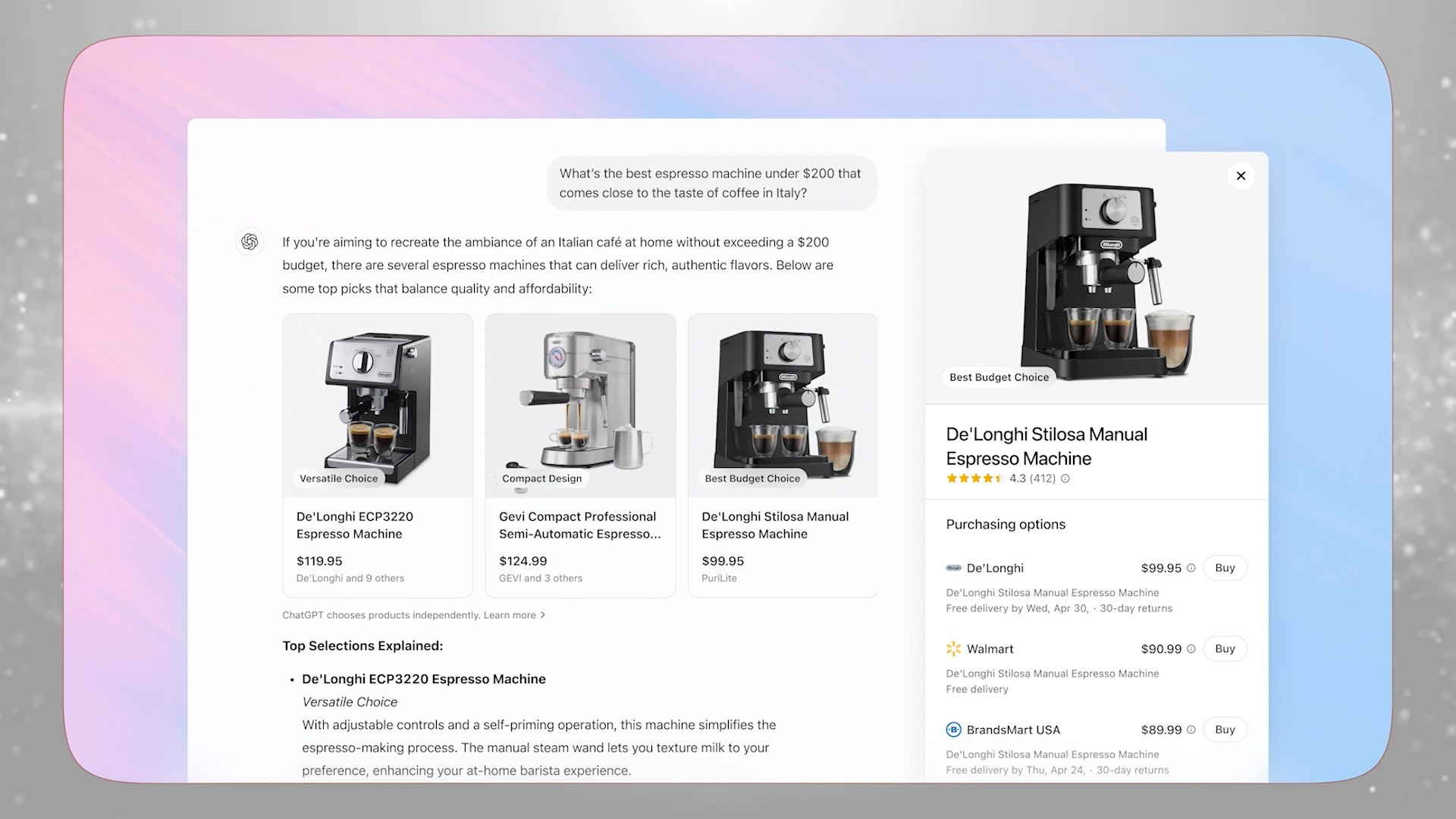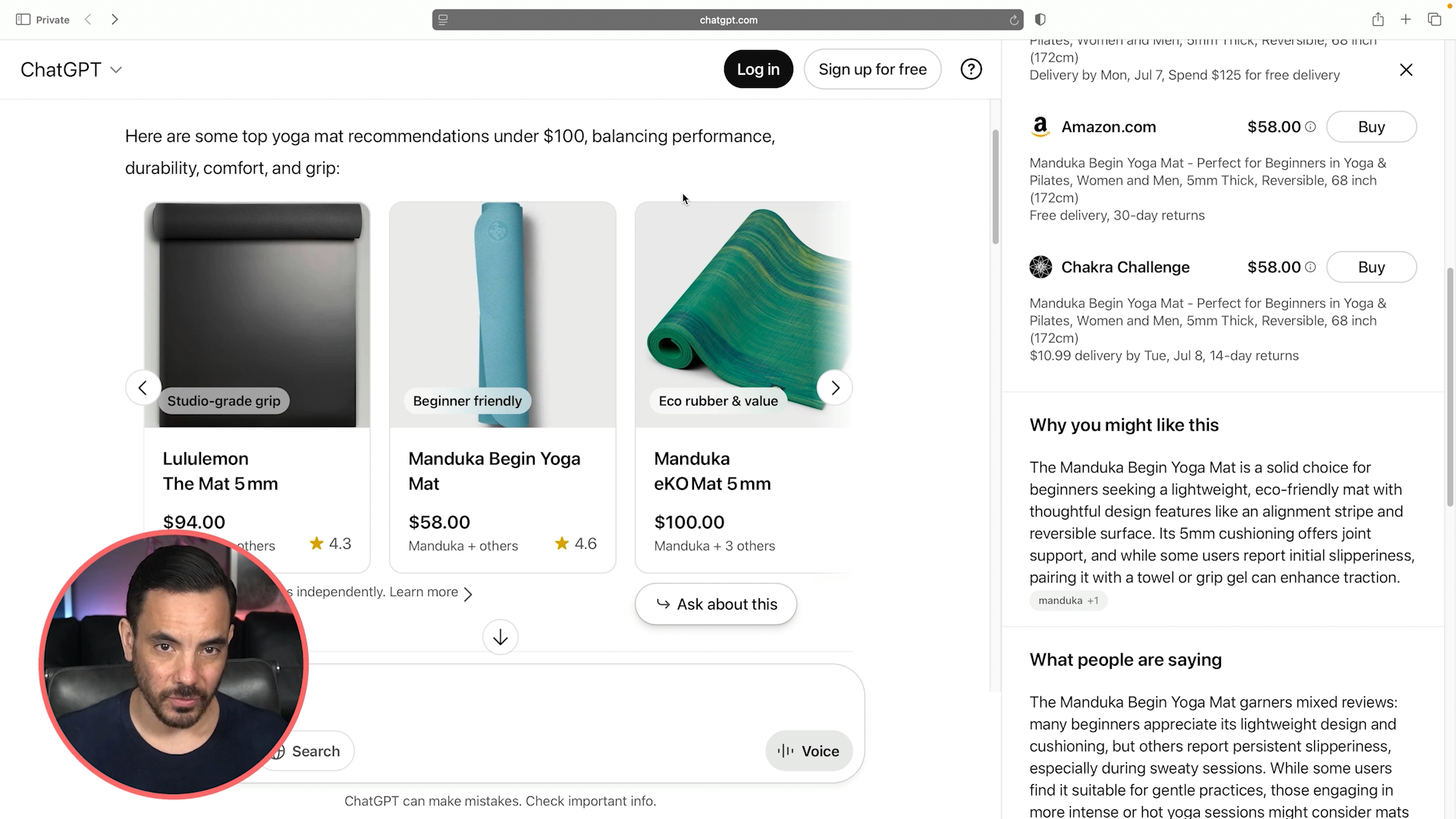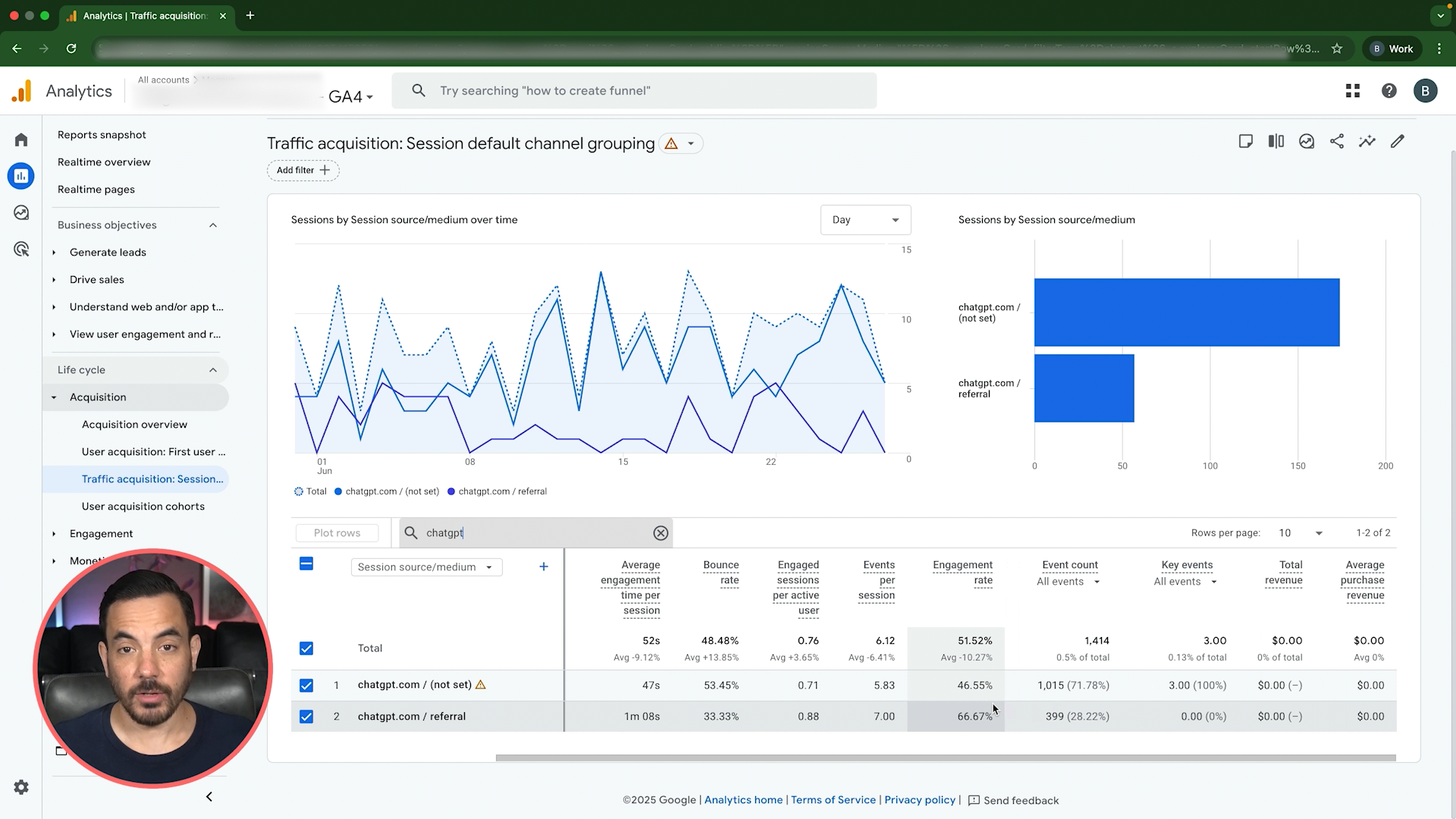ChatGPT Shopping: The Organic Traffic Source You Can’t Afford to Miss
You might not know it yet, but ChatGPT isn’t just an AI chatbot for generating content… it’s now quietly stealing your Google Shopping traffic.
Yep.
ChatGPT has rolled out a shopping feature that lets people ask for product recommendations directly inside the chat. The kicker? If your products aren’t showing up there, your competitors’ might be.
And they won’t pay a penny for that click.
In this blog post, I’ll break down exactly what this new feature is, why it’s a game-changer for ecommerce store owners, and give you the exact steps you need to get your products featured inside ChatGPT Shopping before everyone else catches on.
What Exactly Is ChatGPT Shopping?
When someone types in a shopping-related question — something like “best yoga mat under $100” or “gift ideas for new dads” — ChatGPT now responds with real product recommendations.
These show up as product cards: name, price, image, summary, and sometimes a user rating. People can click through for more details, see buying options from different retailers, or head straight to your site to buy.
It feels like chatting to a mate who’s done all the product research for you.
And here’s the kicker.
It’s not paid ads. It’s organic.
ChatGPT picks the “best fit” products based on what it knows: your product info, your reviews, your reputation, and how well your product fits the buyer’s question.
It’s like a personalised Google Shopping experience that pops up directly inside a conversation.
Shopify Merchants Get an Extra Advantage
If you’re running Shopify, you’re in luck.
ChatGPT integrates directly with Shopify. Instead of crawling your site like Google does for Shopping, it can pull clean, structured product data straight from your Shopify store: titles, images, pricing, stock levels, and variants.
This makes it far easier for ChatGPT to understand what you sell and recommend you accurately.
There’s even chatter that OpenAI and Shopify will soon let people complete a purchase directly inside ChatGPT, so a buyer could go from asking for ideas to paying, without ever leaving the chat. That’s huge for conversion rates.
Why You Should Care
If you run an ecommerce store, you already know the value of high-intent traffic.
Someone asking ChatGPT for a product recommendation isn’t a casual browser, they’re ready to buy. They’re asking for help finding the right option for them, often with a clear budget or need in mind. That’s prime traffic. And right now, it’s free.
OpenAI says ChatGPT now handles about 1 billion searches per week. Some of that is definitely people asking for products. That’s a massive pool of buyers who could see your brand, or your competitors’, recommended for free.
Will ChatGPT always be free? No one knows. There’s plenty of speculation that at some point, ChatGPT might run ads. But for now, there’s no auction. No cost per click. Just a free organic boost for smart brands.
How It Stacks Up Against Google Shopping
With Google Shopping, you pay to play. You upload a product feed to Merchant Center, Google matches that feed to searches, you bid to show up, and you pay per click.
ChatGPT is totally different. It’s conversational. No auction, no bidding, just an AI matching real buyer questions with the best-fitting products it can find.
So this isn’t about ditching your Google Shopping strategy. Keep that running. But think of ChatGPT Shopping as both an opportunity and a defence. If buyers start shifting from Google Shopping searches to asking ChatGPT instead, you want your products showing up in both places.
Where ChatGPT Gets Your Product Data
This is where many store owners will slip up.
ChatGPT is not using your Google Shopping feed. It gets product information in two ways:
By crawling your website. OpenAI’s crawler (called OAI-SearchBot) reads your publicly available pages, just like a person would: titles, descriptions, reviews, and all the context around your product.
Via the Shopify integration. If you’re on Shopify, ChatGPT can pull clean, structured product data directly from your store.
In Google Shopping, your feed is the main source of truth. For ChatGPT, your website content is the source of truth. So if your product pages are half-baked or out of date, you’re making it harder for ChatGPT to pick you.
Product Descriptions Matter Again
In Google Shopping, you can sometimes get away with minimal product descriptions because your feed does the heavy lifting.
With ChatGPT, your on-site descriptions are what the AI reads to decide if your product’s a good match.
So if your descriptions are vague, you probably won’t show up.
Here are my top tips for product descriptions in the ChatGPT era:
Use natural language. Write like a helpful sales assistant, not a robot.
Cover real use cases and pain points. Show you understand what buyers actually care about.
List features, but translate them into benefits. Don’t just say “stainless steel lid”. Explain why it matters.
Answer common questions right in the description. If buyers always ask, “Is this waterproof?”, answer it up front.
5 Practical Steps To Get Featured in ChatGPT Shopping
Alright, let’s get tactical. Here’s what to do next:
Step 1: Check Your Robots.txt File
ChatGPT’s crawler needs access to your site. Make sure you’re not blocking it.
Bad example:
User-agent: *Disallow: /Good example:
User-agent: OAI-SearchBotAllow: /If you’re blocking the bot, it can’t see your products. Simple as that.
Step 2: Optimise Your Product Pages
Use clear titles with relevant keywords.
Write full, natural, helpful descriptions.
Add an FAQ section if you can.
Use high-quality images from multiple angles. Lifestyle shots help too.
The better your page content, the clearer the picture ChatGPT has.
Step 3: Add Trust Signals
Show off reviews and ratings on your product pages. Mark them up with proper structured data so crawlers pick them up.
Get your products mentioned on trusted blogs, review sites, or by influencers. ChatGPT treats this like digital word-of-mouth.
Step 4: Use Structured Data
Structured data (schema markup) helps ChatGPT and other AI tools read your product details correctly.
Most modern Shopify themes handle this out of the box, but double-check. Tools like Google’s Rich Results Test can show you what data is visible. If you need to fix it, apps like JSON-LD for SEO make it simple.
Step 5: Register with OpenAI
OpenAI is building a way to submit product data directly. It’s not open yet, but you can get on the waitlist here: OpenAI Product Discovery.
Be first in line when they open it up.
How To Track ChatGPT Traffic
No dashboard yet, but it’s easy to check.
ChatGPT adds a utm_source=chatgpt.com tag to any link it shares.
In Google Analytics 4:
Go to Reports > Acquisition > Traffic acquisition
Segment by source/medium
Search for chatgpt
See sessions, conversion rates, and revenue.
Some brands are already seeing up to 15% of traffic coming from ChatGPT. That’s an outlier for now, but you should know what your share looks like.
Get In Early, Or Get Left Behind
ChatGPT Shopping is real. It’s new. And it’s growing fast.
If you’ve put all your effort into your Google Shopping feed, great. Now do the same for your actual site content. Because that’s what ChatGPT sees.
Get your site ready now, get in early, and enjoy the free organic traffic while it’s still free.
Conclusion
To sum it up: ChatGPT Shopping is an emerging source of free, high-intent organic traffic for ecommerce brands. Unlike Google Shopping, it’s conversational, feed-free and powered by your on-page product content.
Make sure your robots.txt is open to the OpenAI crawler. Polish your product pages so they’re clear and convincing. Use structured data and get reputable mentions online. And get yourself on OpenAI’s list for future product feed access.
Do it now — while your competitors are still snoozing.



